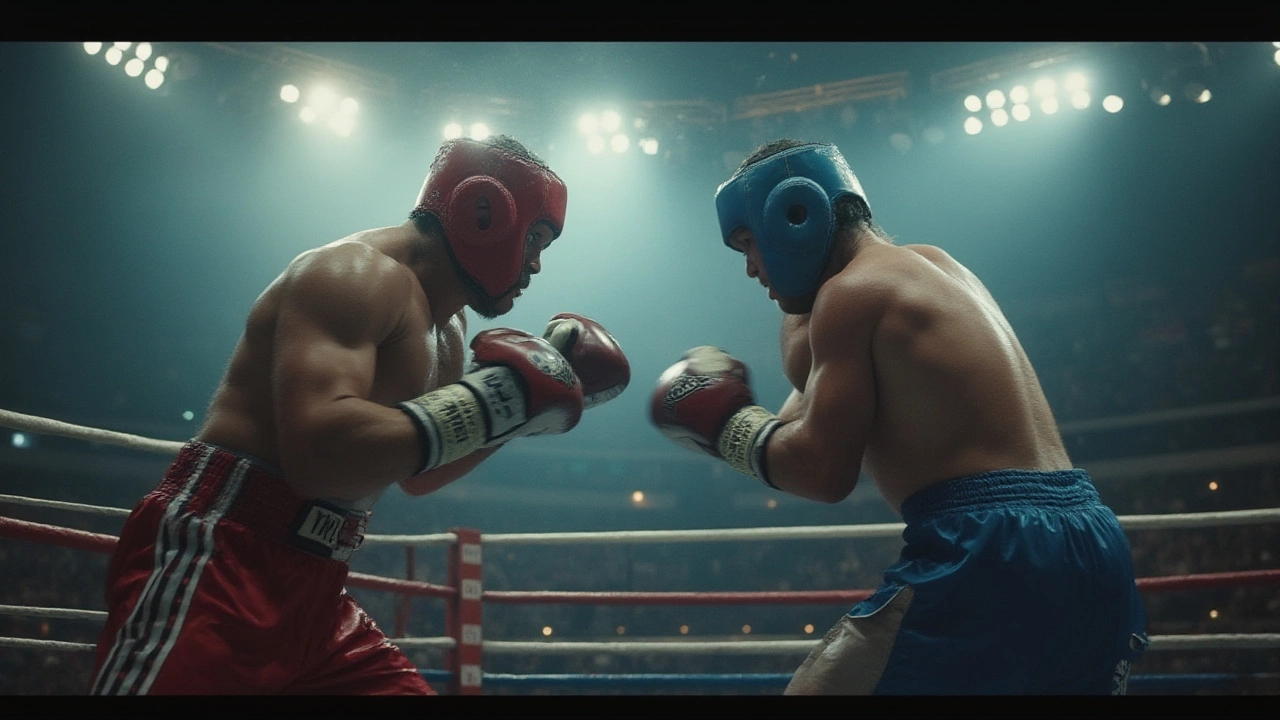What Does 1 2 3 Mean in Boxing? Breaking Down Boxing Punch Number Systems

Ever watched a boxing match, heard someone shout '1-2-3,' and wondered if you’d missed a secret code? Those numbers aren’t just random shouts from the corner—they're the backbone of how boxers train, communicate, and execute their craft. Understanding the punch numbering system isn't just for trainers and pros. Even if you’re brand new to boxing, this system unlocks the logic of combinations, lets you follow real bouts with fresh eyes, and can transform a casual kid on the heavy bag into someone who really looks like they know what they’re doing. So, what’s really behind 1-2-3 in boxing?
The Origins and Purpose of Numbered Punches
That famous combination—1-2-3—isn’t just stuff boxers call out to impress their mates. The boxing punch numbering system started out as a simple way for trainers and fighters to communicate quickly, especially during fast-paced drills or fights. Picture yourself gasping for air, gloves up, eyes swimming in sweat—no one wants to hear 'throw a left jab, immediately followed by a straight right, then hook with your lead hand!' It’s much easier when your coach just says 'one-two-three.' Done.
Let’s break down what each number means. '1' is always the jab, your bread and butter, usually thrown with your lead hand (so, your left if you’re right-handed). '2' is the cross, coming from your rear hand and packed with more power. '3' is the lead hook, swinging in from the side to catch your opponent off guard. These numbers weren’t picked out of a hat. They actually reflect a logical order, moving from the straightest, quickest punch to the heavier, looping shot.
This system saves a ton of time in the gym. You don’t need a PhD in boxing history to see why trainers love it—not only does it keep things moving, but it helps younger boxers and even seasoned pros drill combinations until they become second nature. If you were at my local Bristol gym, you’d see everyone from kids to seasoned county champs snapping out jabs and crosses to the beat of 'one-two, one-two-three' from their trainers.
But the punch numbers aren’t universal—different gyms and countries sometimes put their unique twist on these codes. In some old-school clubs, for example, the numbers go further, with uppercuts and overhands thrown into the mix. But wherever you’re learning, 1-2-3 is always the jab-cross-hook combo. Nice and simple. And it’s not just for training either—it pops up in commentary, in tutorials online, or when you’re messing about with mates on the pads in your garden.
The Building Blocks: The Core Punches (The "1", "2", and "3")
The famous '1-2-3' covers the basics—the jab, cross, and lead hook—but each carries its own flavor and purpose. The jab (the '1') is your scout, testing the range and disrupting your opponent’s rhythm. Some reckon that the majority of legendary fights are won or lost on the strength of a boxer’s jab. Not surprising, really, as it keeps you safe while scoring points and sets up every other punch.
The cross (the '2') is the power shot coming from the opposite side—a real knockout threat if you land it clean. If you’re right-handed, the cross is thrown with your right hand from the rear, traveling in a straight line across your body. It’s what you often see when boxers put their full weight behind a punch, pivoting their hips, digging their feet into the canvas, and letting rip. There’s a reason the heavyweight division is filled with stories of famous right crosses changing the course of fights in seconds.
The hook (the '3') is that sneaky curving punch, usually coming in from the lead hand, targeting the side of your opponent’s head or body. Get this right, and opponents won’t see it coming. It’s the punch with a real wow effect—think Ricky Hatton flooring opponents with a lead hook to the liver, or Katie Taylor changing up angles in a tight scrap. Hooks take coordination, timing, and confidence, which is why trainers start introducing them only after boxers have their stance, guard, and basic punches nailed down.
But here’s a lesser-known fact—even among experienced gym-goers—about how to practice them. Trainers like to call out 'one-two-three' to help boxers chain the moves together, drilling muscle memory and rhythm. Try shadowboxing at home, and you’ll notice that chaining these three moves feels way more natural than you might expect. The key is to relax your shoulders, keep your guard snug, and let your hips do a lot of the work—it’s less about pure arm speed, more about whole body movement. My own partner, Liam, once tried nailing a clean hook after a long day at work and nearly spun off balance—reminding us that perfecting your three can take months or even years of tinkering.

Boxing Combinations and the Power of "1 2 3"
So, what makes '1 2 3' so handy in real matches? Boxing isn’t just a wild brawl. It’s all about setting traps, changing tempos, and throwing your opponent off. All of that starts with combinations—and the '1-2-3' is the most trusted combo in the sport. When you throw a jab, you distract or push your opponent's gloves out of the way. That opens a pathway for the cross. But after the cross, many opponents brace for a retreat—this is exactly when you swing in with a hook and catch them off balance.
Good trainers constantly drill '1-2-3' because it reads the opponent’s reactions and sets up opportunities to score cleanly. These days, even fitness-focused boxing classes in cities like Bristol are built around this combination. It’s a full-body workout too: jab to test, cross to attack, hook for surprise. Each punch makes the next one easier to land. You’ll see pros like Anthony Joshua and old-school fighters like Sugar Ray Leonard using 1-2-3 in world title bouts, not just on the bags.
But here’s where things get fun. Once you get those three moves down, you can start freestyling combinations—adding in uppercuts, doubling up on jabs, throwing in a duck after a hook. Coaches call these 'advanced numbers.' In some gyms, you might hear shouts like '1-2-5-3' (jab, cross, lead uppercut, hook) or 'double jab, two, three.' If you watch hours of classic boxing footage, you’ll notice how often that initial 1-2 opens the door for a winning hook. The number system helps boxers stay unpredictable—a split-second hesitation can cost you the round.
For someone watching at home, knowing the basics of these codes can transform how you see a fight. Instead of trying to track every glove, you can predict what’s likely to come next or why a boxer is swaying side to side setting up a hook. These simple numbers let you keep up with a sport famous for its speed and intensity.
Tips for Mastering the Boxing Punch Number System
Ready to get your own 1-2-3 combo firing? It’s all about repetition and timing. You don’t need expensive kit or a posh gym—just a little space, a mirror, and some patience. Try this: Practice your jab until it feels snappy and relaxed. Only then add the cross, making sure to rotate your hips and transfer your weight. Finally, bolt on the hook, focusing on keeping your lead elbow up and turning your body into the shot, not just swinging your arm.
Trainers recommend rehearsing this series of moves slowly at first, then ramping up the speed as it becomes muscle memory. Don’t worry about looking flashy. The quiet secret of boxing is that tidy, sharp basics beat messy power every time. Trust me, I learned more about '1 2 3' timing by recording myself on my phone in the kitchen than from any YouTube highlight reel.
One underrated tip: keep your non-punching hand glued to your cheek. When you throw a jab, your rear hand should be protecting your chin. After you cross, your lead glove guards your face. Even in the hook, you stay covered. UK coaches love this because defense is nearly as important as offense, no matter how tempting it feels to swing big.
If you have a partner or a pal (like Liam helping me out on a bored Sunday), let them hold focus mitts and call out combos: '1-2! 1-2-3!' It feels a bit silly at the start but hearing and reacting to the numbers sharpens your reflexes. Many boxing apps and smart home devices now offer virtual coaches who will call out combinations—though nothing replaces a shouting Bristol trainer with a knowing smile. If you’re a parent, getting your kids into the habit of learning '1 2 3' early is a game changer. I’ve seen shy 10-year-olds grow as confident as little tigers in just a few weeks of practice.
Another tip: mix up the speed and power. Try '1' as a quick snap, slow down the '2' for accuracy, then rip into the '3.' This rhythm keeps your opponent guessing. Professional boxers often say the punch that does the damage is the one they didn’t see coming—and it's those little rhythm changes that create openings.

Beyond 1 2 3: Expanding Your Boxing Vocabulary
Once you’ve nailed the basic punch numbers, the boxing world opens up. Trainers often teach a full menu of punches, each with a number. In most British and American gyms, the system goes like this:
- 1 = Jab (lead hand)
- 2 = Cross (rear hand)
- 3 = Lead hook
- 4 = Rear hook
- 5 = Lead uppercut
- 6 = Rear uppercut
This means combos can get inventive—'1-2-5-2' is jab, cross, lead uppercut, cross. The system brings everyone up to speed fast, especially in classes where there might be over twenty boxers training together. Even international pros like Canelo Álvarez and Claressa Shields learned to rely on punch numbers for drills and fight strategies.
Then there’s the wild stuff: feints, slips, pivots, rolls. But no one gets there without first owning the 1-2-3. Some coaches will add 'double jab' (so, '1-1-2') or mix in head movement ('1-slip-2'). All the top-world trainers talk in this shorthand on fight night. Listen closely during pay-per-view matches, and you’ll hear ringside corners yelling these combos over the roar of a thousand fans.
Now, not every boxer or trainer sticks to the exact same numbering. In some old-school clubs in Wales and Scotland, you might find slight tweaks or unique names for punches. But the basics stay the same. The 1-2-3 system is so universal, you can walk into almost any boxing gym on the planet and catch on in minutes. That’s what makes it powerful—it’s the closest thing boxing has to a common language, letting boxers of all ages, backgrounds, and languages get straight to business.
One last thing—learning boxing punch numbers isn’t just about looking good on the bags. It’s about using a proven, global language to improve your technique, read fights better, and get more out of every training session. When you know the numbers, you’re in on the secret—ready to spot opportunities, attack, defend, and keep the rhythm flowing until the final bell.
